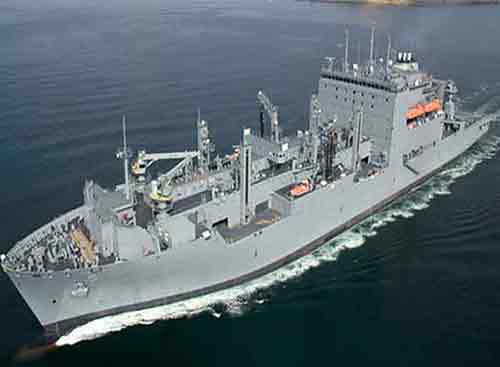Asbestos on U.S. Navy Ammunition Ships

Used to deliver important supplies to combatant ships at sea, U.S. Navy ammunition ships carry more than ammunition and missiles. They also transport food, parts for repairs, and small amounts of fuel, when necessary. Due to the dangers of carrying such volatile cargo, though, these ships aim to make deliveries in safe spots at sea, out of enemy lines of fire. Ammunition ships became a staple in the fleet before and during World War II, and they continue to serve our country today.
Any veteran who served on an ammunition ship could have been exposed to asbestos on a daily basis. Ammunition ships built before the 1980s used asbestos-containing materials in equipment in the engine room and boiler spaces, as well as throughout the rest of the ship. Any service member who was charged with operation, repair, or maintenance of asbestos-containing parts and equipment on ammunition ships were at high risk of exposure to the cancer-causing material.
Navy veterans who served on ammunition ships decades ago are now coping with asbestos-related diseases such as mesothelioma, lung cancer, and asbestosis. If you or a loved one has been diagnosed with an asbestos disease, you may have a right to compensation from the asbestos corporations that sold these dangerous products to the U.S. Navy.
At Belluck & Fox LLP, our nationally recognized asbestos attorneys have secured more than $800 million for deserving asbestos victims and their families. Schedule a free consultation with our compassionate legal team now to learn how we can help you and your family after a mesothelioma diagnosis.
History of U.S. Navy Ammunition Ships
The first ammunition ship, Pyro (AE-1), was laid down in August 1918 at the Navy Yard in Puget Sound, Washington. Launched in 1919, the ship primarily traveled between ports ranging from Puget Sound to Boston, including Mare Island, San Francisco, San Diego, Guantanamo Bay, Norfolk (Virginia), Philadelphia, and New York, according to a history documented by GlogalSecurity.org. Ramping up to World War II, the U.S. continued constructing ammunition ships to support its combatant ships at sea.
Those who served on ammunition ships played a crucial role in wartime efforts, but they also faced great risks. Despite their great utility in times of war, ammunition ships have been the sites of terrible tragedy. One of the most historic examples occurred in November 1944, when an accident on the AE Mount Hood detonated a massive explosion at the Manus Naval Base in the Admiralty Islands. The blast destroyed the ship and damaged other vessels in the area, leaving hundreds dead and many more missing.
Due to the dangers associated with loading and unloading munitions into the vessels, the Navy developed safety procedures, training, and certification to protect those working around ammunition ships. The military also redesigned the munitions to improve safety while loading.
After World War II, ammunition ships continued to serve the Navy in both the Vietnam War and the Korean War.
In 2006, the U.S. Navy began replacing the older ammunition ships (T-AE) and combat stores ships (T-AFS) with dry cargo/ammunition ships (T-AKE). These ships are operated by the Navy’s Military Sealift Command.
List of Ammunition Ships in U.S. Navy
The Navy’s original ammunition ships (AE) were often named after volcanoes. Some of the ammunition ships Navy veterans may have served on include:
- Mauna Loa
- Sangay
- Wrangell
- Firedrake
- Vesuvius
- Mount Katmai
- Great Sitkin
- Paricutin
- Diamond Head
- Suribachi
- Mauna Kea
- Nitro
- USS Pyro
- Haleakala
- Kilauea
- Butte
- Santa Barbara
- Mount Hood
- Chara
- Flint
- Shasta
- Mount Baker
- Kiska
Where Was Asbestos Used on U.S. Navy Ammunition Ships?
Countless veterans and civilian seamen and shipyard workers were exposed to asbestos.
Veterans who served on ammunition ships may have been exposed to asbestos while working with or in the vicinity of:
- Pumps, valves, boilers, and turbines
- Floor tiles and decking
- Cement
- Insulation
- Gaskets and packing
- Insulated gloves
- Other equipment
Many veterans who handled asbestos materials often worked in tight spaces with poor ventilation, putting them at high risk for inhaling or ingesting the dangerous fibers. Those who served on ammunition ships but did not work directly with asbestos-containing materials still may have been exposed.
Legal Help for Navy Veterans Who Are Diagnosed with Mesothelioma
If you or a family member has been diagnosed with mesothelioma or another asbestos disease after serving on a U.S. Navy ammunition ship, you should learn about your right to compensation. The nationally recognized asbestos attorneys at Belluck & Fox have earned a reputation for standing up for the rights of veterans and their families who are coping with these life-threatening diseases. We have more than 20 years of experience investigating where asbestos materials were used on Navy ammunition ships and other vessels, and our team is dedicated to fighting for maximum compensation for those who were harmed due to their exposure.
Contact us today to schedule a free, no obligation case consultation, and learn how our attorneys can help you and your family pursue the compensation you deserve.
Sources:
